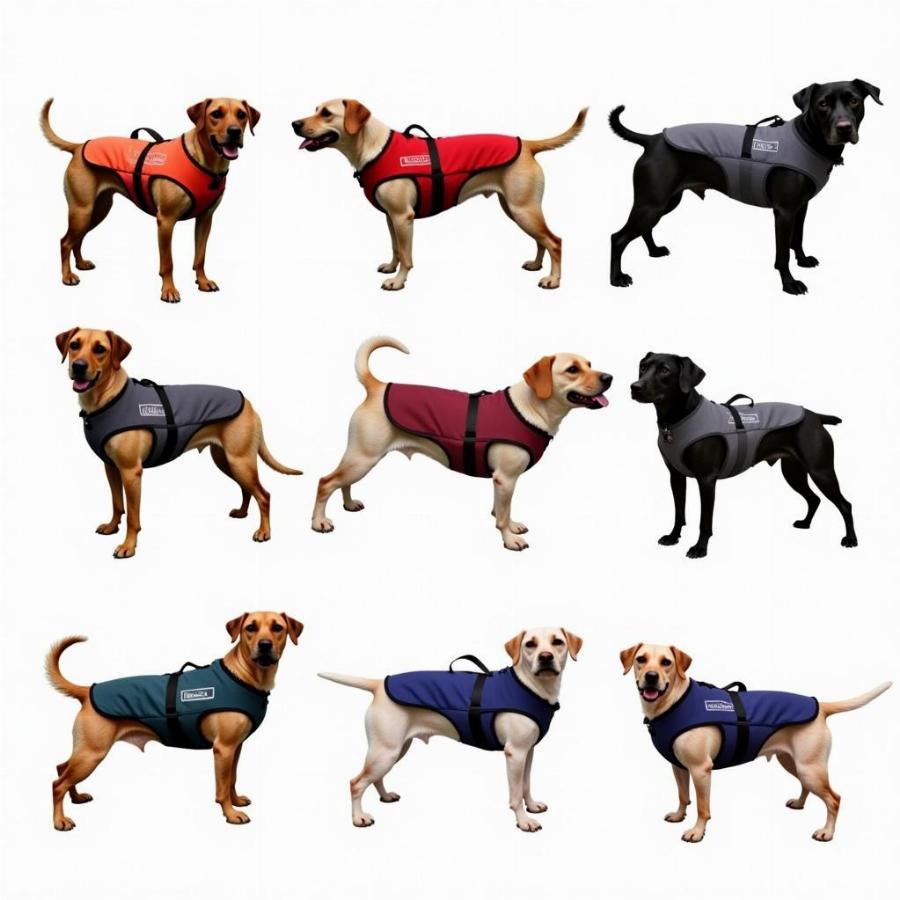A weighted dog vest for anxiety is becoming an increasingly popular tool for pet parents looking for natural ways to soothe their anxious dogs. But what exactly is a weighted vest, and how can it benefit your furry friend? This comprehensive guide will cover everything you need to know about weighted vests for dogs, from how they work to choosing the right one for your canine companion.
Understanding Canine Anxiety and How Weighted Vests Can Help
Just like humans, dogs can experience anxiety from various triggers, including loud noises, separation from their owners, unfamiliar environments, or even changes in routine. This anxiety can manifest in various ways, such as excessive barking, destructive behavior, trembling, panting, or pacing.
Weighted vests work on the principle of Deep Pressure Therapy (DPT), similar to the feeling of being hugged or swaddled. The gentle, distributed pressure from the vest helps:
- Reduce Cortisol Levels: Cortisol is a hormone released during times of stress. The calming effect of DPT can help lower cortisol levels, promoting relaxation.
- Release Endorphins: DPT can stimulate the release of endorphins, which have mood-boosting and pain-relieving effects.
- Provide a Sense of Security: The feeling of being hugged can be very comforting for dogs, especially those dealing with fear or anxiety.
Choosing the Right Weighted Vest for Your Dog
Selecting the appropriate weighted vest for your dog is crucial for their comfort and safety. Here’s what to consider:
1. Weight Distribution: Look for vests with evenly distributed weight across the dog’s body, avoiding any pressure points.
2. Material and Fit: Choose a vest made from breathable, durable, and washable material. Ensure a snug but comfortable fit that allows for a full range of motion.
3. Weight: The general rule of thumb is to use a vest that’s about 5-10% of your dog’s body weight. However, it’s best to start with a lower weight and gradually increase it if needed.
4. Your Dog’s Needs: Consider your dog’s specific anxiety triggers. For example, a vest might be helpful during thunderstorms, fireworks, or car rides.
 Various Weighted Vests for Dogs
Various Weighted Vests for Dogs
Introducing the Weighted Vest to Your Dog
It’s essential to introduce the vest slowly and positively to avoid creating negative associations:
- Start with short durations: Begin with just a few minutes of wear, gradually increasing the time as your dog becomes more comfortable.
- Use positive reinforcement: Reward your dog with treats, praise, and petting while wearing the vest.
- Monitor your dog’s behavior: Observe for any signs of discomfort or stress and adjust accordingly. If your dog seems distressed, remove the vest and consult your veterinarian.
Weighted Vests: Not a Standalone Solution
While weighted vests can be a valuable tool for managing anxiety in dogs, it’s crucial to remember they’re not a cure-all.
“Think of the weighted vest as an extra layer of support,” says Dr. Emily Parker, a certified veterinary behaviorist. “It can help create a calmer state of mind, but it’s essential to address the underlying causes of anxiety with training, behavior modification, and in some cases, medication.”
Conclusion
Weighted dog vests for anxiety can be a valuable addition to your anxiety management toolkit, providing comfort and support for your furry friend. By understanding how they work, choosing the right vest, and using it appropriately, you can help your dog feel calmer and more relaxed in stressful situations. Remember to consult your veterinarian to rule out any underlying medical conditions and discuss if a weighted vest is a suitable option for your dog.
Frequently Asked Questions
1. Can I leave the weighted vest on my dog all the time?
No, it’s not recommended to leave the vest on your dog for extended periods. Start with short durations and gradually increase as your dog adjusts. Always supervise your dog while wearing the vest.
2. Can a weighted vest cure my dog’s anxiety?
While weighted vests can significantly reduce anxiety symptoms, they’re not a cure. They should be used with other anxiety management techniques like training and behavior modification.
3. What if my dog doesn’t like the weighted vest?
Not all dogs tolerate weighted vests. If your dog shows signs of distress, remove the vest and consult your veterinarian or a certified dog trainer for alternative solutions.
4. Can puppies wear weighted vests?
It’s best to consult your veterinarian before using a weighted vest on a puppy. Their bones and joints are still developing, and the added weight might be detrimental.
5. Are there any side effects of using a weighted vest?
While generally safe, some dogs might experience discomfort, chafing, or overheating. Ensure the vest fits correctly and monitor your dog for any adverse reactions.
Looking for More Information on Canine Care?
Visit Beaut Dogs at https://beautdogs.com for a wealth of resources on dog breeds, health, nutrition, training, and everything in between. At Beaut Dogs, we’re dedicated to providing you with expert advice and reliable information to help you give your furry friend the best possible care. If you need personalized support, don’t hesitate to contact our team at [email protected] for detailed and accurate answers.